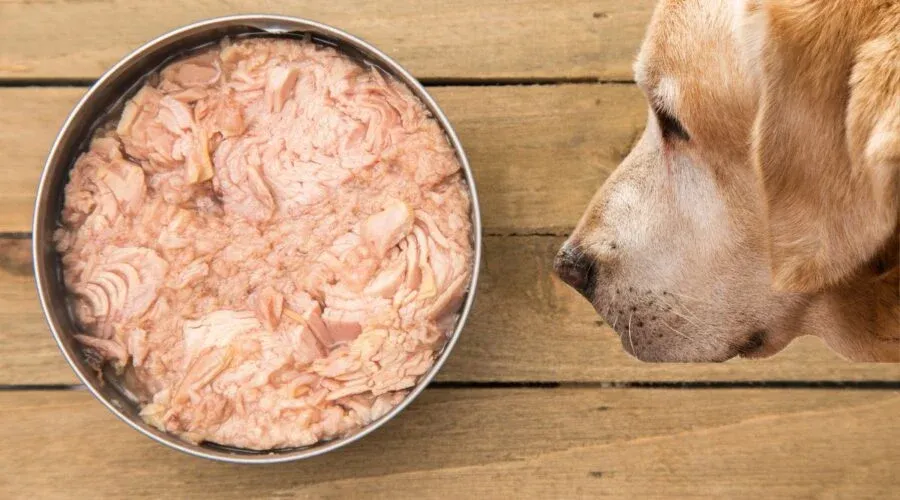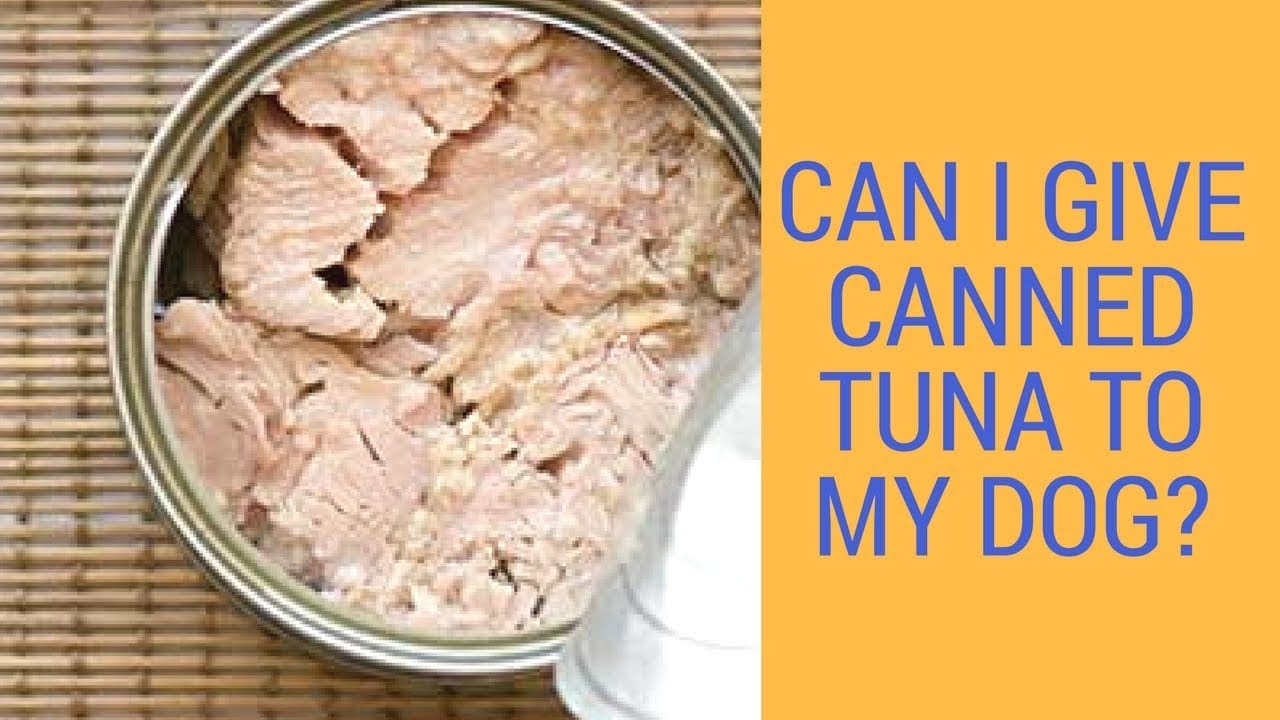Mixing tuna with dog food is a topic that has been gaining popularity among pet owners. It is believed that adding tuna to dog food can provide additional nutrients and flavor to their meals. However, there are also concerns about the safety and potential risks of feeding tuna to dogs.

Tuna is a rich source of protein, omega-3 fatty acids, and other essential nutrients that are beneficial to both humans and dogs. Some pet owners mix tuna with their dog's food to enhance the taste and provide additional nutrition. However, it is important to note that not all types of tuna are safe for dogs to consume. Some species of tuna, such as bluefin and bigeye, contain high levels of mercury, which can be toxic to dogs if consumed in large amounts.
Pet owners should also be aware of the potential risks associated with feeding tuna to dogs. Some dogs may be allergic to fish or experience digestive issues after consuming tuna. Additionally, feeding dogs a diet that is high in fish can lead to an imbalance of nutrients and cause health problems in the long run. It is important to consult with a veterinarian before making any significant changes to a dog's diet.

Benefits of Mixing Tuna with Dog Food
Nutritional Enhancement
Tuna is a rich source of protein and omega-3 fatty acids, which are essential for a dog's overall health. By mixing tuna with dog food, pet owners can provide their furry friends with a nutritional boost. Omega-3 fatty acids can help reduce inflammation, improve brain function, and promote healthy skin and coat. Protein is essential for building and repairing tissues and helps maintain a dog's muscle mass.
Palatability Improvement
Some dogs can be picky eaters and may refuse to eat their regular dog food. Mixing tuna with dog food can make the food more appealing and increase the chances of the dog eating it. Tuna has a strong aroma and flavor that can entice even the most finicky eaters. Additionally, the texture of the tuna can add a different dimension to the dog's meal, making it more enjoyable for them.
Diet Variation
Feeding a dog the same food every day can become monotonous, and they may lose interest in their meals. Mixing tuna with dog food can provide some variety and keep the dog interested in their food. It is important to note that while variety is essential, it is also important to maintain a balanced diet for the dog. Pet owners should consult with their veterinarian to ensure that the dog's nutritional needs are being met.
In conclusion, mixing tuna with dog food can provide several benefits for dogs. It can enhance their nutrition, improve the palatability of their food, and provide some variety in their diet. However, it is important to ensure that the dog's nutritional needs are being met and that the tuna is not the sole source of their diet.
Considerations Before Mixing Tuna with Dog Food
When considering mixing tuna with dog food, there are a few important factors to keep in mind to ensure your pet's health and safety.
Allergy and Sensitivity Checks
Before introducing any new food to your dog's diet, it's important to check for potential allergies or sensitivities. Tuna is a common allergen for dogs, and symptoms can range from mild itching to more severe reactions such as vomiting or difficulty breathing. It's recommended to introduce tuna in small amounts and monitor your dog's reaction closely.
Tuna Selection and Quality
When selecting tuna for your dog, it's important to choose high-quality, fresh tuna. Avoid canned tuna that contains added salt or other preservatives, as these can be harmful to your dog's health. It's also important to avoid tuna that has been exposed to high levels of mercury, as this can lead to mercury poisoning in dogs.
Portion Control and Frequency
While tuna can be a healthy addition to your dog's diet, it should be given in moderation. Too much tuna can lead to digestive issues such as diarrhea or vomiting. It's recommended to limit tuna to once or twice a week, and to give it in small portions as a treat or mixed with your dog's regular food.
By keeping these considerations in mind, you can safely introduce tuna into your dog's diet and provide them with a healthy and tasty treat.
Preparation Methods
Mixing Techniques
When it comes to mixing tuna with dog food, there are a few techniques that can be used to ensure that the two ingredients are blended together properly. One popular method is to simply mix the tuna and dog food together in a bowl using a spoon or fork. This method is quick and easy, but it may not result in the most evenly mixed product.
Another option is to use a food processor or blender to mix the tuna and dog food together. This method can be more time-consuming, but it ensures that the ingredients are thoroughly combined and can result in a smoother texture.
Serving Suggestions
Mixed tuna and dog food can be served in a variety of ways. One option is to simply spoon the mixture into a dog bowl and serve it as is. Another option is to use the mixture as a topping for dry kibble or wet food. This can add some variety to a dog's diet and make mealtime more interesting.
For dogs who are picky eaters, it may be helpful to add some additional flavors or textures to the mixture. For example, some dogs may enjoy the addition of chopped vegetables or cooked rice.
Storage and Handling
Mixed tuna and dog food should be stored in an airtight container in the refrigerator. It is important to use the mixture within a few days to ensure that it stays fresh and safe for your dog to eat.
When handling the mixture, it is important to practice good food safety habits. This includes washing your hands before and after handling the ingredients, using clean utensils and bowls, and avoiding cross-contamination with other foods.
Potential Health Concerns
Mercury Content in Tuna

Tuna contains high levels of mercury, which can be harmful if consumed in excess. Mercury is a toxic metal that can cause damage to the nervous system, kidneys, and other organs. Pregnant women, nursing mothers, and young children are particularly vulnerable to the effects of mercury.
To reduce the risk of mercury exposure, it is recommended to limit the consumption of tuna and other fish with high mercury levels. The FDA advises that adults should eat no more than 2-3 servings of tuna per week, while children should consume even less.
Risk of Dietary Imbalance
Mixing tuna with dog food can lead to a dietary imbalance in dogs. Tuna is high in protein and omega-3 fatty acids, which are beneficial for dogs in moderation. However, excessive consumption of tuna can lead to an imbalance of nutrients, as well as an excess of mercury.
Dog food is formulated to provide a balanced diet for dogs, and should be the primary source of nutrition. Tuna can be given as an occasional treat, but should not be a staple of a dog's diet.
Choking Hazards
Tuna can pose a choking hazard for dogs, especially if it is not properly prepared. Tuna bones can be sharp and difficult to digest, and can become lodged in a dog's throat or digestive tract.
To reduce the risk of choking, it is important to remove all bones and skin from tuna before feeding it to a dog. Tuna should also be cooked thoroughly to ensure that it is safe to eat.
Dog Food Recipes Incorporating Tuna
Tuna is a great source of protein and omega-3 fatty acids for dogs. It can be mixed with dog food to create a tasty and nutritious meal for your furry friend. Here are some dog food recipes incorporating tuna that you can try at home.
Homemade Tuna Dog Food Recipes
Tuna and Rice
Ingredients:
- 1 can of tuna
- 1 cup of cooked rice
- 1/2 cup of chopped vegetables (carrots, peas, green beans)
- 1 tablespoon of olive oil
Instructions:
- Drain the tuna and mix it with the cooked rice in a bowl.
- Add the chopped vegetables and mix well.
- Drizzle olive oil over the mixture and stir until evenly distributed.
- Serve to your dog.
Tuna and Sweet Potato
Ingredients:
- 1 can of tuna
- 1 cooked sweet potato, mashed
- 1/2 cup of chopped spinach
- 1 teaspoon of dried parsley
Instructions:
- Drain the tuna and mix it with the mashed sweet potato in a bowl.
- Add the chopped spinach and dried parsley and mix well.
- Serve to your dog.
Commercial Tuna Dog Food Blends
If you prefer to use commercial dog food blends, there are many options available that incorporate tuna. Here are some popular brands:
- Blue Buffalo Wilderness Grain-Free Adult Wet Dog Food Tuna and Chicken Grill
- Merrick Grain-Free Wet Dog Food Cowboy Cookout
- Wellness CORE Grain-Free Canned Dog Food 95% Tuna and Shrimp
Always check the ingredients and nutritional information before purchasing any commercial dog food. It's important to choose a high-quality brand that meets your dog's nutritional needs.

Incorporating tuna into your dog's diet can provide many health benefits. Whether you choose to make homemade tuna dog food or use a commercial blend, your furry friend is sure to enjoy this delicious and nutritious meal.
Monitoring Your Dog's Health
Observing Reactions to Diet Changes
When introducing a new food to your dog's diet, it is important to monitor their reaction to it. Mixing tuna with dog food can be a great way to add some variety to your dog's meals, but it is important to make the transition gradually. Start by mixing a small amount of tuna with their regular food and gradually increase the amount over a few days.
Watch for any signs of digestive upset such as vomiting, diarrhea, or loss of appetite. If your dog experiences any of these symptoms, it may be a sign that they are not tolerating the new food well. In this case, it is best to stop feeding them the tuna and consult with your veterinarian.
Regular Veterinary Check-Ups
Regular check-ups with your veterinarian are an important part of maintaining your dog's overall health and well-being. During these appointments, your veterinarian can assess your dog's weight, dental health, and overall condition.
If you are planning on introducing a new food to your dog's diet, it is a good idea to discuss it with your veterinarian first. They can provide guidance on how to make the transition and can also advise you on any potential health concerns related to the new food.
In addition to regular check-ups, it is important to keep an eye out for any changes in your dog's behavior or physical condition. If you notice anything out of the ordinary, such as lethargy, changes in appetite, or vomiting, it is important to contact your veterinarian right away. Early intervention can help prevent more serious health issues down the line.
Conclusion

Incorporating tuna into your dog's diet can provide numerous health benefits, including essential nutrients and improved palatability. However, it's crucial to approach this addition with caution, considering factors such as mercury content and potential allergic reactions. By following moderation and safety guidelines, you can safely introduce tuna as a tasty supplement to your dog's regular meals.
Frequently Asked Questions
- Is it safe to add canned tuna to my dog's diet?
- Yes, it is safe to add canned tuna to a dog's diet, but only in moderation. Tuna is a great source of protein and omega-3 fatty acids, which can benefit a dog's health. However, too much tuna can cause mercury poisoning, which can be harmful to dogs.
- What are the benefits of mixing tuna with my dog's regular food?
- Mixing tuna with a dog's regular food can provide additional protein and omega-3 fatty acids, which can help improve a dog's skin and coat health, as well as support their immune system.
- How much tuna is appropriate for a dog to consume daily?
- The amount of tuna a dog can consume daily depends on their size and weight. As a general rule, dogs should not consume more than 10% of their daily caloric intake from treats or table scraps, including tuna. It is recommended to consult with a veterinarian to determine the appropriate amount of tuna for a dog's specific needs.
- Can incorporating tuna in a dog's meal help with digestive issues?
- Tuna can be beneficial for dogs with digestive issues, as it is a lean protein source that is easy to digest. However, it is important to introduce tuna gradually to a dog's diet to avoid any digestive upset.
- Are there any risks associated with feeding dogs tuna mixed with their kibble?
- As mentioned earlier, feeding dogs too much tuna can lead to mercury poisoning, which can cause neurological issues. Additionally, tuna should not be the only source of protein in a dog's diet, as it does not contain all the essential amino acids that dogs need.
- What types of fish, besides tuna, are considered safe for dogs to eat?
- Other types of fish that are considered safe for dogs to eat include salmon, sardines, and mackerel. These fish are also rich in protein and omega-3 fatty acids, and can provide similar health benefits as tuna. However, it is important to ensure that the fish is cooked and boneless, as cooked bones can be harmful to dogs.